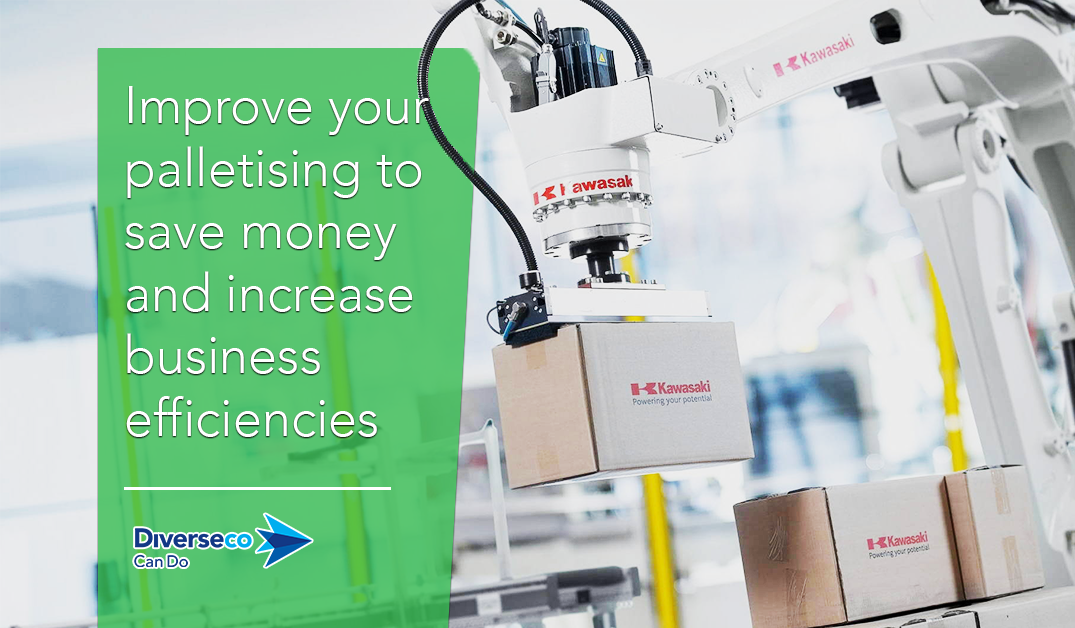
Any industrial and warehousing operation that is still relying on manual palletising is likely to be compromising their productivity, quality and business efficiencies.
Manual palletising is no match for modern automated equipment in terms of speed, precision, productivity, safety, quality and outputs and in today’s highly competitive environment, businesses need to take every opportunity to improve.
Palletising is the final step in an assembly line whereby the products (such as boxes, bags, cases, cartons, bottles, sacks etc) are loaded onto pallets. Semi-automatic and automatic palletising systems have undergone major changes in recent years, with advances in robotics technology driving significant improvements in terms of pallet pattern flexibility, tooling flexibility, cycle times as well as the presentation of the stacked pallets.
In basic terms, a robotic palletiser utilises various end-of-arm-tools which alleviate the need for manual stacking of bags, cartons or drums onto a pallet, thereby increasing productivity and profitability while allowing greater flexibility and versatility.
Although automated palletising equipment requires a capital outlay, many businesses are surprised at just how quickly they get a return on their investment. It doesn’t take long before the companies’ bottom-lines reflect the improvements in productivity and efficiencies that are made possible by the new equipment – and customer satisfaction levels are also a lot higher.
Let’s take a closer look at how palletising equipment will benefit a business:
Speed of operation
Humans can’t compete with automated or even semi-automated palletising equipment when it comes to speed. The equipment works faster than any person possibly can, plus it can operate continuously.
Quality control
Bulk bag fillers generally come in standard sizes, but again, an experienced supplier will be able to custom design a solution to meet your specific needs. Bags of any sizecan be filled using these specialised machines. Automated functionality enables bags to be filled to specific weight or volume requirements and ensure that bags aren’t being over or under-filled.
Reduce labour costs
Eliminating the human element or substantially reducing the level of human intervention leads to substantially lower labour costs and greater efficiencies. The likelihood of error and contamination from human handling is minimised plus there are the obvious productivity and profitability benefits as a result of lower labour costs. Another reason why automated palletisers can improve business efficiencies is that personnel who are no longer required on the manual packing line can be redeployed to other areas within the organisation and used to greater effect.
Greater flexibility
Versatile palletising equipment makes it easy to reconfigure systems to handle different shapes, case sizes, pallet stacking patterns, layers of product and weights as well as handle multiple production lines. This means faster turnaround times and productivity improvements.
Improved working conditions
An automated palletising system reduces the need for workers to do heavy lifting and repetitive work, and minimises the likelihood of OH&S issues. Due to the nature of repetitive manual handling, injuries are often caused by more than just a wrong place at the wrong time. With extensive repetition comes the risk of repetitive stress injuries, attrition of certain muscle groups due to potential improper techniques, and over-exposure to hazardous scenarios possibly leading to eventual incidents to name a few. Incorporating a robotic solution to these hazardous tasks means a safer working environment with reduced likelihood of workplace injuries and costly workers compensation claims: protect your employees and ensure their well-being and you will protect your business.
Improved data handling and reporting
Computerized controls and a seamless interface with other business software systems allow improved data gathering, real-time reporting and analysis as well as reducing invoicing errors and enabling a more streamlined and secure information chain.
More efficient use of floor space
A robotic palletiser generally occupies less space than a manual operation which means businesses can use their square meterage more cost-effectively. In some instances, operations are even able to reduce the size of their factory or warehouse, which results in substantial cost savings.
If you’d like to learn more about how your business could save money and improve efficiencies with an automated palletising system, you should talk to the professionals at Diverseco. They’re a leading supplier of packing, filling, bagging and palletising machinery and equipment and they have the answers on how you can increase your productivity, reduce your personnel requirements and minimise the risk of injury. Find out more by talking with one of Diverseco’s palletising professionals to learn more about our extensive range of palletising equipment and solutions.

